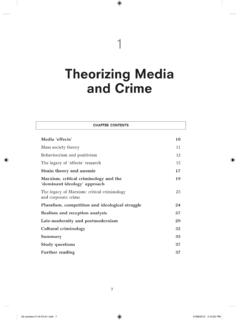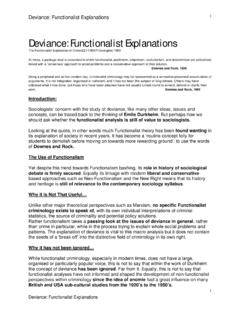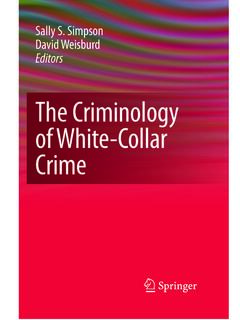Transcription of Major Sociological Theoretical Approaches in Criminology 7
1 7 Major Sociological Theoretical Approaches in CriminologyAnomie Theories mile Durkheim and AnomieMerton s Theory of AnomieRobert Agnew s General Strain Theory (GST)Subcultural TheoriesCohen s Lower-Class Reaction TheoryCloward and Ohlin s Differential Opportunity TheorySocial Process TheoriesThe Chicago SchoolShaw and McKay s Social Disorganization TheorySutherland s Theory of Differential AssociationCrime File Designing Out CrimeMiller s Focal Concerns TheoryMatza s Delinquency and Drift TheorySocial Control TheoriesReckless s Containment TheoryHirschi s Social Bond TheoryGottfredson and Hirschi s General Theory of CrimeJohn Hagan s Power-Control TheoryDevelopmental and Life Course
2 (DLC) TheoriesFarrington s Antisocial Potential (AP) TheorySampson and Laub s Life Course CriminalityThe Theory Policy ConnectionSummaryKey ConceptsReview QuestionsWeb SourcesWeb ExercisesSelected Readingschapter156 mile DurkheimSociological Mainstream TheoriesPositive Criminology accounts for too much delinquency. Taken at their terms, delinquency [crime] theories seem to predicate far more delinquency than actually occurs. If delinquents were in fact radically different from the rest of conventional youth .. then involvement in delinquency would be more permanent and less transient, more pervasive and less intermittent than is apparently the case.
3 Theories of delinquency yield an embarrassment of riches, which seemingly go unmatched in the real world. David Matza (1964)The early classical, biological, and psychological traditions in Criminology theory were similar in their rel-atively conservative view of society (the consensus model) as well as in their search for the cause of crime in the lack of fear of deterrence, defective individual genetics, or the psyche. The individual criminal was the unit of analysis. The only departures from this deviant behavior approach to criminality were found in the writings of the economic theorists (Marx and Bonger) and the ecologists (Quetelet and Guerry).
4 Economic and ecological theories constitute the groundwork for the preeminence of Sociological Approaches to criminologi-cal theory beginning in the 1930s in the United States. Societal conditions, groups, social disorganization, and conflict have become additional units of analysis. Crime is perceived as a status (definition) as well as behav-ior (pathology), and Sociological Criminology in general takes a more critical stance toward the society itself as generator of criminal Podcast to the author s podcast for this TO CRIMINOLOGY158 Major Sociological Theoretical Approaches in CriminologyTable is a more detailed outline of the Sociological theories that were briefly presented in Table , Major Theoretical Approaches in Criminology .
5 These include mainstream Sociological theories: anomie, social process, social control, and developmental and life course will begin with the mainstream tradition and the views of late-nineteenth-century sociologist mile Durkheim and the anomie theories that he inspired. Other representatives of this approach are Robert Merton, Richard Cloward and Lloyd Ohlin, and Albert SchoolMajor Themes/ConceptsMajor TheoristsSociological MainstreamCrime reflects consensus modeAnomie TheoryAnomie (normlessness) lessens social controlAnomie (gap between goals and means)
6 Creates devianceDifferential social opportunityLower-class reaction to middle-class valuesDurkheimMertonCloward and OhlinCohenSocial ProcessSocial disorganization and social conditionsRoutine activitiesCrime is learned behavior, culturally/subculturally transmittedLocal concerns of lower classSubterranean values, drift techniques of neutralizationShaw and McKayCohen and FelsonSutherlandMillerMatzaSocial Control Containment theorySocial bonds weakened, reducing individual stakes in conformityLow self-control and self-interestRecklessHirschiGottfredson and HirschiDevelopmental/Life CourseAntisocial potentialLongitudinal studiesLife course criminalityFarringtonBlumsteinSampson and LaubNote.
7 *See Table for other Theoretical Approaches in B L E Major Theoretical Approaches in Mainstream Criminology ( Sociological )*Anomie Theories mile Durkheim and AnomieThe writings of French sociologist mile Durkheim (1858 1917) were in sharp contrast to the social Darwinist, individualist, and psychological and biological positivist theories dominant in the late nineteenth century. The works of Durkheim represented a return to the thinking and orientation of the statistical/ecological theories advocated by Quetelet and Guerry, an approach that had been preempted by the popularity of Lombroso and the early biological his works, which included The Division of Labor in Society (1964), originally published in 1893, and Suicide (1951), first released in 1897, Durkheim insisted on the primacy of groups and social organizations as explana-tory factors of human misconduct.
8 As we said in Chapter 1, he viewed crime as a normal phenomenon in society because group reactions to deviant actions assist human groups in defining their moral boundaries. In his doc-toral dissertation, The Rules of Sociological Method (1895/1950), which was completed in 1893, Durkheim defined Handbook Article Link an article on strain 7. Sociological Mainstream Theories159the sociologist s role as that of systematic observers of social facts, empirically observable group characteristics that affect human behavior. Durkheim s analysis of suicide clearly demonstrated his hypothesis of group influ-ences on individual propensity to suicide.
9 In Suicide, he identified several types, which included altruistic ( self-less suicide), egoistic (self-centered suicide), and anomic (suicide due to anomie or a state of normlessness in society). The latter concept is Durkheim s principal contribution to the field of term anomie appeared in the English language as early as 1591 and generally referred to a disregard for law (V. Fox, 1976, p. 115). Anomie, from the Greek anomia ( without norms ), as used by Durkheim involves a moral malaise, a lack of clear-cut norms with which to guide human conduct (normlessness).
10 It may occur as a pervasive condition because of a failure of individuals to internalize the norms of society, an inability to adjust to changing norms, or even conflict within the norms trends in modern urban-industrial societies result in changing norms, confusion, and lessened social control over the individual. Individualism increases and new lifestyles emerge, perhaps yielding even greater freedom but also increasing the possibility for deviant behavior. The close ties of the individual to the family, village, and tradition (what Durkheim calls mechanical solidarity ), though confining to the individual, maintained social control.
















